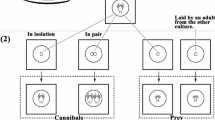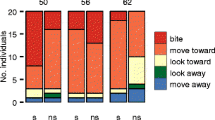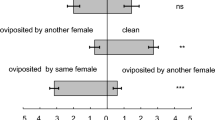Abstract
Cannibalism is a widespread behavioral phenomenon that is often thought to be an adaptive plastic response to limited environmental resources. However, cannibalism can potentially come at a fitness cost to an individual if one consumes relatives, due to the potential loss of indirect fitness benefits. One way in which this cost could be avoided is by the selective avoidance of cannibalising kin in favour of consuming non-kin conspecifics through the use of kin recognition mechanisms. Here, we examined whether fruit fly (Drosophila melanogaster) 2nd instar larvae differ in their interactions with groups of related and unrelated eggs, and whether this is associated with differential rates of cannibalism. Our experiment revealed that, at this developmental stage larvae appear to be able to distinguish between full-sibling eggs and non-kin eggs, as they behaved differently towards these two groups. Larvae approached groups of unrelated eggs more frequently and spent more time overall associating with them than they did with groups of related eggs. Furthermore, larvae cannibalized unrelated eggs significantly more frequently than kin eggs. These results are consistent with a kin-selection behavioral strategy that maximizes both direct and indirect fitness benefits. We discuss these findings in the context of this species’ natural history, and the potential mechanisms of kin recognition. This study contributes to the growing body of research examining the evolution of social behaviors using this model species.


Similar content being viewed by others
References
Ahmad M, Chaudhary S, Afzal A, Tariq M (2015) Starvation-induced dietary behavior in Drosophila melanogaster larvae and adults Sci Rep:5
Anthony C (2003) Kinship influences cannibalism in the wolf spider, Pardosa milvina. J Insect Behav 16:23–36
Ashburner M, Thompson JN Jr (1978) The laboratory culture of Drosophila. In: Ashburner M, Wright TRF (eds) The genetics and biology of Drosophila. Academic Press, London
Bakula M (1969) The persistence of a microbial flora during post-embryogenesis of Drosophila melanogaster. J Invertebr Pathol 14:365–374
Barkae E, Scharf I, Ovadia O (2016) A stranger is tastier than a neighbor: cannibalism in Mediterranean and desert antlion populations. Behav Ecol 28:69–76
Bayoumy M, Michaud J (2015) Egg cannibalism and its life history consequences vary with life stage, sex, and reproductive status in Hippodamia convergens (Coleoptera: Coccinellidae). J Econ Entomol 108:1665–1674
Bazazi S, Buhl J, Hale JJ, Anstey ML, Sword GA, Simpson SJ, Couzin ID (2008) Collective motion and cannibalism in locust migratory bands. Curr Biol 18:735–739
Blum JE, Fischer CN, Miles J, Handelsman J (2013) Frequent replenishment sustains the beneficial microbiome of Drosophila melanogaster. MBio. 4:e00860–e00813
Bilde T, Lubin Y (2001) Kin recognition and cannibalism in a subsocial spider. J Evol Biol 14:959–966
Breed M (2014) Kin and nestmate recognition: the influence of W. D. Hamilton on 50 years of research. Anim Behav 92:271–279
Brookes M (2001) Fly the unsung hero of twentieth-century science. Phoenix, London
Bry C, Gillet C (1980) Reduction of cannibalism in pike (Esox lucius) fry by isolation of full-sib families. Reprod Nutr Dev 20:173–182
Camiletti A, Thompson G (2016) Drosophila as a genetically tractable model for social insect behavior. Front Ecol Evol 4
Chiang H, Hodson A (1950) An analytical study of population growth in Drosophila melanogaster. Ecol Monogr 20:173–206
Crosland M (1990) Variation in ant aggression and kin discrimination ability within and between colonies. J Insect Behav 3:359–379
Davis R (2011) Traces of Drosophila memory. Neuron 70:8–19
De Jong G (1976) A model of competition for food I. frequency dependent viabilities. Am Nat 110:1013–1027
De Nardin J, Da Silva L, Araújo A (2016) Kin recognition in a butterfly: inferences about its heritability. Ethol Ecol Evol 29:255–265
Dewsbury D (1988) Kinship, familiarity, aggression, and dominance in deer mice (Peromyscus maniculatus) in seminatural enclosures. J Comp Psychol 102:124–128
Duelli P (1981) Is larval cannibalism in lacewings adaptive? (Neuroptera: Chrysopidae). Res Popul Ecol 23:193–209
Durisko Z, Dukas R (2013) Attraction to and learning from social cues in fruit fly larvae. Proc R Soc Lond B 280:20131398–20131398
Durisko Z, Kemp R, Mubasher R, Dukas R (2014) Dynamics of social behavior in fruit fly larvae. PLoS One 9:e95495
Guedes RNC, Guedes NMP, Smith RH (2007) Larval competition within seeds: from the behavior process to the ecological outcome in the seed beetle Callosobruchus maculatus. Austral Ecology 32:697–707
Hamilton WD (1964) The genetical evolution of social behavior I and II. J Theor Biol 7:1–52
Hoffmann AA, Nielsen KM (1985) The effect of resource subdivision on genetic variation in Drosophila. Am Nat 125:421–430
Joshi A, Knight C, Mueller L (1996) Genetics of larval urea tolerance in Drosophila melanogaster. Heredity 77:33–39
Kaznowski C, Schneiderman H, Bryant P (1985) Cuticle secretion during larval growth in Drosophila melanogaster. J Insect Physiol 3:801–813
Khodaei L, Long TAF (2020) Kin recognition and co-operative foraging in Drosophila melanogaster larvae. J Evol Biol (in press)
Liu T, Wang Y, Tian Y, Zhang J, Zhao J, Guo A (2018) The receptor channel formed by ppk25, ppk29 and ppk23 can sense the Drosophila female pheromone 7,11-HD. Genes Brain Behav Epub Oct 22:e12529
Lockwood J (1989) Ontogeny of cannibalism in rangeland grasshoppers (Orthoptera: Acrididae). J. Kansas Entomo Soc 62:534–541
Marshall J (2016) What is inclusive fitness theory, and what is it for? Curr Opin Behav Sci 12:103–108
Martin E, Long TAF (2015) Are flies kind to kin? The role of intra- and inter-sexual relatedness in mediating reproductive conflict. Proc R Soc Lond B 282:20151991
Michaud J, Grant A (2004) Adaptive significance of sibling egg cannibalism in Coccinellidae: comparative evidence from three species. Ann Entomol Soc America 97:710–719
Narasimha S, Nagornov K, Menin L, Mucciolo A, Rohwedder A, Humbel B, Stevens M, Thum AS, Tsybin YO, Vijendravarma RK (2019) Drosophila melanogaster cloak their eggs with pheromones, which prevents cannibalism. PLoS Biol 17:e2006012
Osborne KA, Robichon A, Burgess E, Butland S, Shaw RA, Coulthard A, Pereira HS, Greenspan RJ, Sokolowski MB (1997) Natural behavior polymorphism due to a cGMP-dependent protein kinase of Drosophila. Science 277:834–836
Pervez A, Gupta A, Omkar O (2005) Kin recognition and avoidance of kin cannibalism by the larvae of co-occurring ladybirds: a laboratory study. European Journal of Entomology 102(3):513–518
Pfennig D (1997) Kinship and cannibalism. Biosci 47:667–675
Pfennig D, Ho S, Hoffman E (1998) Pathogen transmission as a selective force against cannibalism. Anim Behav 55:1255–1261
Pfennig D, Loeb M, Collins J (1991) Pathogens as a factor limiting the spread of cannibalism in tiger salamanders. Oecologia 88:161–166
Pravosudova E, Grubb T, Parker P (2001) The influence of kinship on nutritional condition and aggression levels in winter social groups of tufted titmice. Condor 103:821–828
Core Team R (2016) R: a language and environment for statistical computing. In: R Foundation for statistical computing. Austria. URL, Vienna https://www.R-project.org/
Reaume CJ, Sokolowski MB (2006) The nature of Drosophila melanogaster. Curr Biol 16:R623–R628
Richardson ML, Mitchell RF, Reagel PF, Hanks LM (2010) Causes and consequences of cannibalism in noncarnivorous insects. Annu Rev Entomol 55:39–53
Rose M (1984) Laboratory evolution of postponed senescence in Drosophila melanogaster. Evo 38:1004–1010
Saitoh F, Choh Y (2018) Role of kin recognition in oviposition preference and cannibalism by the predatory mite Gynaeseius liturivorus. Experimental & Applied Acarology 76:149–160
Schausberger P, Croft B (2001) Kin recognition and larval cannibalism by adult females in specialist predaceous mites. Anim Behav 61:459–464
Scharf I (2016) The multifaceted effects of starvation on arthropod behavior. Anim Behav 119:37–48
Scherer S, Stocker R, Gerber B (2003) Olfactory learning in individually assayed Drosophila larvae. Learn Mem 10:217–225
Simpson SJ, Sword GA, Lorch PD, Couzin ID (2006) Cannibal crickets on a forced march for protein and salt. Proc Natl Acad Sci U S A 103:4152–4156
Spieth HT (1974) Courtship behavior in Drosophila. Annu Rev Entomol 19:385–405
Sokolowski MB (2001) Drosophila: genetics meets behavior. Nat Rev Genet 2:879–890
Sokolowski MB (2010) Social interactions in “simple” model systems. Neuron 65:780–794
Torchiano M (2016) Effsize: efficient effect size computation. R package version 0.7.0. https://CRAN.R-project.org/package=effsize
Viblanc V, Pasquaretta C, Sueur C, Boonstra R, Dobson F (2016) Aggression in Columbian ground squirrels: relationships with age, kinship, energy allocation, and fitness. Behav Ecol 6:1716–1725
Vijendravarma RK, Narasimha S, Kawecki TJ (2013) Predatory cannibalism in Drosophila melanogaster larvae. Nat Commun 4:1–8
Waldman B (1988) The ecology of kin recognition. Annu Rev Ecol Syst 19:543–571
Walls S, Roudebush R (1991) Reduced aggression toward siblings as evidence of kin recognition in cannibalistic salamanders. Am Nat 138:1027–1038
Weiner J (2000) Time, love, memory: a great biologist and his quest for the origins of behavior, 1st edn. Vintage Books, New York
Wong CNA, Ng P, Douglas AE (2011) Low-diversity bacterial community in the gut of the fruit fly Drosophila melanogaster. Eviron Microbiol 13:1889–1900
Wu Q, Wen T, Lee G, Park J, Cai H, Shen P (2003) Developmental control of foraging and social behavior by the Drosophila neuropeptide Y-like system. Neuron 39:147–161
Yang D (2018) Carnivory in the larvae of Drosophila melanogaster and other Drosophila species. Sci Rep 8
Acknowledgements
We would like to thank the members of the Long Lab: Heather L. Malek, Matt Maoloni, Tijana Lazova, Jordan Hyde, Renee Garant and others for their assistance with fly-pushing and larvae wrangling. Dr. Scott Ramsay, Dr. Noam Miller and Dr. Sally LePage are thanked for their helpful feedback. Dr. Anne Wilson is thanked for the use of the room in which recordings were made. TAFL was funded with a Natural Sciences and Engineering Research Council (NSERC) Discovery grant. This work was conducted at Wilfrid Laurier University, which exists on the traditional territory of the Neutral, Anishnawbe, and Haudenosaunee peoples.
Author information
Authors and Affiliations
Corresponding author
Ethics declarations
Competing Interests
The authors declare no competing interests.
Ethics
This study did not require approval from an ethics committee.
Supporting Data
All data analyzed in this manuscript will be available in the Data Dryad archive upon acceptance of the manuscript.
Additional information
Publisher’s note
Springer Nature remains neutral with regard to jurisdictional claims in published maps and institutional affiliations.
Rights and permissions
About this article
Cite this article
Khodaei, L., Long, T.A. Kin Recognition and Egg Cannibalism by Drosophila melanogaster Larvae. J Insect Behav 33, 20–29 (2020). https://doi.org/10.1007/s10905-020-09742-0
Received:
Revised:
Accepted:
Published:
Issue Date:
DOI: https://doi.org/10.1007/s10905-020-09742-0




